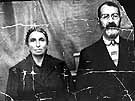
|
|
|

|

|

|

|
|
Click on an image to see a larger, more detailed picture.
|
|
|
|
|
| 1944: Desperate Acts |

|
pg. 552 |

|
|
|
|
| |
 With tags attached to their clothing, refugees arrive at the Fort Ontario camp in Oswego, New York. Opened in 1944, the camp served as a temporary refuge for nearly 1000 European Jews, along with a few non-Jews. With little initial hope of staying in the United States after the war ended, the refugees suffered from low morale and anxiety about their future. In December 1945 President Harry Truman eased restrictions, allowing the refugees to remain in the U.S. if they wished.
With tags attached to their clothing, refugees arrive at the Fort Ontario camp in Oswego, New York. Opened in 1944, the camp served as a temporary refuge for nearly 1000 European Jews, along with a few non-Jews. With little initial hope of staying in the United States after the war ended, the refugees suffered from low morale and anxiety about their future. In December 1945 President Harry Truman eased restrictions, allowing the refugees to remain in the U.S. if they wished.
Photo: Ruth Gruber/United States Holocaust Memorial Museum Photo Archive
|
 Yohovet and Abraham Alcana, Sephardic Jews from the island of Rhodes, pose solemnly for the photographer. Nazi efforts to eradicate the island's Jews accelerated in the summer of 1944 when Adolf Eichmann sent his assistant, Anton Burger, to the island. Jews were assembled at various points and sent by ship to Athens, where they were imprisoned before being sent to Auschwitz. Abraham, age 70, and Yohovet, age 60, were among those whom the Nazis deemed too old for work. They were consigned to the gas chambers upon their arrival at Auschwitz.
Yohovet and Abraham Alcana, Sephardic Jews from the island of Rhodes, pose solemnly for the photographer. Nazi efforts to eradicate the island's Jews accelerated in the summer of 1944 when Adolf Eichmann sent his assistant, Anton Burger, to the island. Jews were assembled at various points and sent by ship to Athens, where they were imprisoned before being sent to Auschwitz. Abraham, age 70, and Yohovet, age 60, were among those whom the Nazis deemed too old for work. They were consigned to the gas chambers upon their arrival at Auschwitz.
Photo: United States Holocaust Memorial Museum Photo Archive
|
 Fort Ontario
Fort Ontario
Beginning in August 1944, Fort Ontario in Oswego, New York, provided a haven to 982 refugees, mostly Jews, from 17 countries. Liberated by the Allies in southern Italy, they received sanctuary in the "free port" on the condition they return to their homelands at the end of the war. Inmate numbers were limited to allay fears that the U.S. might be overwhelmed by a tide of penniless Jewish refugees at war's end. Confined to the camp, many people despaired. One mother, with two sons who had emigrated earlier and were fighting in the U.S. Army, faced the heartbreaking predicament of never seeing them if she were to be repatriated. First Lady Eleanor Roosevelt was deeply touched by the refugees' plight, but noted "that people in wartime are not logical, and Congress acts in the way people at home want them to act."
Photo: Ruth Gruber / United States Holocaust Memorial Museum Photo Archive
|
|

|

|

|

|
 August 23, 1944: The regime of Romanian dictator Ion Antonescu is overthrown. Romania joins the Allies.
August 23, 1944: The regime of Romanian dictator Ion Antonescu is overthrown. Romania joins the Allies.
|
 August 24, 1944: Three thousand slave laborers are killed at Mielec, Poland.
August 24, 1944: Three thousand slave laborers are killed at Mielec, Poland.
|
 August 24, 1944: A Jewish survivor in liberated Lvov, Ukraine, notes in her diary that only three percent of the region's Jews remain alive.
August 24, 1944: A Jewish survivor in liberated Lvov, Ukraine, notes in her diary that only three percent of the region's Jews remain alive.
|
 August 25, 1944: German forces surrender in Paris. Large numbers of Jews join Free French forces in the battle to liberate Lyons.
August 25, 1944: German forces surrender in Paris. Large numbers of Jews join Free French forces in the battle to liberate Lyons.
|
 August 25, 1944: Adolf Eichmann and his staff leave Hungary, effectively ending Nazi deportations of Hungarian Jews.
August 25, 1944: Adolf Eichmann and his staff leave Hungary, effectively ending Nazi deportations of Hungarian Jews.
|
|
|
|
|
| 1944: Desperate Acts |

|
pg. 552 |

|
|
The Holocaust Chronicle
© 2009 Publications International, Ltd.
|
|
